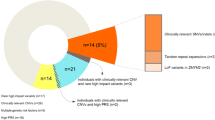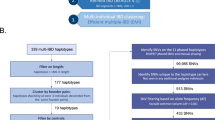Abstract
Linkage disequilibrium (LD) mapping was used to follow up reports of linkage between reading disability (RD) and an 18 cM region of chromosome 6p21.3–22. Using a two-stage approach, we tested for association between RD and 22 microsatellite markers in two independent samples of 101 (Stage 1) and 77 (Stage 2) parent/proband trios in which RD was rigorously defined. The most significant replicated associations were observed between combinations of markers D6S109/422/1665 (Stage 1, P=0.002 (adjusted for multiple testing); Stage 2, P=0.0001) and D6S506/1029/1660 (Stage 1, P=0.02 (adjusted), Stage 2, P=0.0001). The only two-marker association observed in both samples was with D6S422/1665 (P=0.01, 0.04). No single marker showed replicated association but D6S506 produced values of P=0.01 and 0.08 which were significant when combined (P=0.02). We observed weaker and less consistent evidence of association in a region of confirmed linkage to RD in previous studies. The most consistently significant haplotypic association D6S109/422/1665, showed association with single-word reading, spelling, phonological awareness, phonological decoding, orthographic accuracy and random automised naming, but not with vocabulary or Attention Deficit Hyperactivity Disorder. Our findings strongly support the presence of a gene contributing to RD in a region of chromosome 6 between markers D6S109 and D6S1260, but do not rule out the presence of a gene between D6S1556 and MOG.
This is a preview of subscription content, access via your institution
Access options
Subscribe to this journal
Receive 12 print issues and online access
$259.00 per year
only $21.58 per issue
Buy this article
- Purchase on Springer Link
- Instant access to full article PDF
Prices may be subject to local taxes which are calculated during checkout


Similar content being viewed by others
References
Shaywitz BA, Fletcher JM, Holahan JM, Shaywitz SE . Discrepancy compared to low achievement definitions of reading disability. J Read Dis 1992; 25: 639–648.
Maughan B . In: Hulme C, Snowling M (eds). Reading Development and Dyslexia. Whurr: London, 1994, pp 128–143.
Maughan B, Hagell A . Poor readers in adulthood: psychosocial functioning. Dev Psychopathol 1996; 8: 457–476.
Paulesu E, Frith U, Snowling M, Gallagher A, Morton J, Frackowiak RSJ et al. Is developmental dyslexia a disconnection syndrome? Evidence from PET scanning. Brain 1996; 119: 143–157.
Stevenson J, Graham P, Fredman G, McLoughlin V . A twin study of genetic influences on reading and spelling ability and disability. J Child Psychol Psychiatry 1987; 28: 229–247.
DeFries JC, Gillis JJ . Nurture and psychology. In: Plomin, R, McClearn GF (eds). Nature. APA Books: New York, 1993, pp 121–145.
Hinshelwood J . Letter-, Word-, and Mind-Blindness. Lewis & Son: London, 1900.
DeFries JC, Fulker DW, Labuda MC . Evidence for a genetic etiology in reading disability of twins. Nature 1987; 329: 537–539.
Pennington BF, Gilger JW, Pauls D, Smith SA, Smith SD, DeFries JC . Evidence for major gene transmission of developmental dyslexia. JAMA 1991; 266: 1527–1534.
Hohnen B, Stevenson J . The structure of genetic influences on general cognitive, language, phonological and reading abilities. Dev Psychol 1999; 35: 590–603.
Gilger JW, Borecki IB, DeFries JC, Pennington BF . Commingling and segregation analysis of reading performance families of normal reading probands. Behav Genet 1994; 24: 345–355.
Grigorenko EL, Wood FB, Meyer MS, Hart LA, Speed WC, Shuster A et al. Susceptibility loci for distinct components of developmental dyslexia on chromosomes 6 and 15. Am J Hum Genet 1997; 60: 27–39.
Smith SD, Kimberling WJ, Pennington BF . Specific reading disability—identification of an inherited form through linkage analysis. Science 1993; 219: 1345.
Schulte-Korne G, Grimm T, Nothen NM, Muller-Myshok B, Cichon S, Vogt IR et al. Evidence for linkage of spelling disability to chromosome 15. Am J Hum Genet 1998; 63: 279–282.
Morris DW, Robinson L, Turic D, Duke M, Webb V, Milham C et al. Family-based association mapping provides evidence for a gene for reading disability on chromosome 15q. Hum Mol Genet 2000; 9: 855–860.
Nopola-Hemmia J, Taipale M, Haltia T, Lehesjoki A-E, Voutilainen A, Kere J . Two translocations of chromosome 15q associated with dyslexia. J Med Genet 2000; 37: 771–775.
Bisgaard ML, Eiberg H, Moller N, Niebuhr E, Mohr J . Dyslexia and chromosome 15 heteromorphism–negative lod in a Danish material. Clin Genet 1987; 32: 118–119.
Cardon LR, Smith SD, Fulker DW, Kimberling WJ, Pennington BF, DeFries JC . Quantitative trait locus for reading disability on chromosome 6. Science 1994; 266: 276–279.
Cardon LR, Smith SD, Fulker DW, Kimberling WJ, Pennington BF, DeFries JC . Quantitative trait locus for reading disability. Science 1995; 268: 1553.
Grigorenko EL, Wood FB, Meyer MS, Pauls DL . Chromosome 6p influences on different dyslexia-related cognitive processes: further confirmation. Am J Hum Genet 2000; 66: 715–723.
Fisher SE, Marlow AJ, Lamb J, Maestrini E, Williams DF, Richardson AJ et al. A quantitative-trait locus on chromosome 6p influences aspects of developmental dyslexia. Am J Hum Genet 1999; 64: 146–156.
Gayan J, Smith SD, Cherny SS, Cardon LR, Fulker DW, Brower AM et al. Quantitative-trait for specific language and reading deficits on chromosome 6p. Am J Hum Genet 1999; 64: 157–164.
Kaplan DE, Won TW, Ahn J, Pauls D, Olson R, DeFries J et al. Linkage disequilibrium studies of reading disability on 6p22. American Society of Human Genetics 50th Annual Meeting 2000; one page abstract.
Fagerheim T, Raeymaekers P, Tonnessen FE, Pedersen M, Tranebjaerg L, Lubs HA . A new gene (DYX3) for dyslexia is located on chromosome 2. J Med Genet 1999; 36: 664–669.
Petryshen TL, Kaplan BL, Hughes ML, Field LL . Evidence for the chromosome 2p15–p16 dyslexia susceptibility locus (DYX3) in a large Canadian data set. Am J Med Genet 2000b; 96: 047—one page abstract.
Fisher SE, Francks C, Marlow AJ, MacPhie IL, Newbury DF, Cardon LR et al. Independent genome-wide scans identify a chromosome 18 quantitative-trait locus influencing dyslexia. Nat Genet 2002; 30: 86–91.
Petryshen TL, Kaplan BJ, Liu MF, Field LL . Absence of significant linkage between phonological coding dyslexia and chromosome 6p23–21.3, as determined by use of quantitative-trait methods: confirmation of qualitative analyses. Am J Hum Genet 2000a; 66: 708–714.
Field LL, Kaplan BJ . Absence of linkage of phonological coding dyslexia to chromosome 6p23–p21.3 in a large family data set. Am J Hum Genet 1998; 63: 1448–1456.
Abecasis GR, Noguchi E, Heinzmann A, Traherne JA, Bhattacharyya S, Leaves NI et al. Entent and distribution of linkage disequilibrium in three genomic regions. Am J Hum Genet 2001; 68: 191–197.
Terwilliger JD, Weiss KM . Linkage disequilibrium mapping of complex disease: fantasy or reality? Pharm Biol 1998; 8: 579–598.
Kruglyak L . Prospects for whole-genome linkage disequilibrium mapping of common disease genes. Nat Genet 1999; 22: 139.
Reich DE, Cargill M, Bolk S, Ireland J, Sabeti PC, Richter DJ et al. Linkage disequilibrium in the human genome. Nature 2001; 411: 199–203.
Huttley GA, Smith MW, Carrington M, O'Brien SJ . A scan for linkage disequilibrium across the human genome. Genetics 1999; 152: 1711–1722.
Kidd JR, Pakstis AJ, Zhao H, Lu RB, Okonofua FE, Odunsi A et al. Haplotypes and linkage disequilibrium at the phenylalanine hydroxylase locus, PAH, in a global representation of populations. Am J Hum Genet 66: 1882–1899.
Copeman JB, Cucca F, Hearne CM, Cornall RJ, Reed PW, Ronningen KS et al. Linkage disequilibrium mapping of a type 1 diabetes susceptibility gene (IDDM7) to chromosome 2q31–q33. Nat Genet 1995; 9: 80–85.
Merriman TR, Eaves IA, Twells RCJ, Merriman ME, Danoy PAC, Muxworthy CE et al. Transmission of haplotypes of microsatellite markers rather than single marker alleles in the mapping of a putative type 1 diabetes susceptibility gene (IDDM6). Hum Mol Genet 1998; 7: 517–524.
Nakagawa Y, Kawaguchi Y, Twells RCJ, Muxworthy C, Hunter KMD, Wilson A et al. Fine mapping of the diabetes-susceptibility locus, IDDM4, on chromosome 11q13. Am J Hum Genet 1998; 63: 547–556.
Oka A, Tamiya G, Tomizawa M, Ota M, Katsuyama Y, Makino S et al. Association analysis using refined microsatellite markers localizes a susceptibility locus for psoriasis vulgaris within a 111 kb segment telomeric to the HLA-C gene. Hum Mol Genet 1999; 8: 2165–2170.
Ogura Y, Bonen DK, Inohara N, Nicolae DL, Chen FF, Ramos R et al. A frameshift mutation in NOD2 associated with susceptibility to Crohn's disease. Nature 2001; 411: 603–606.
Wechsler D . WISC III U.K, 3rd edn. The Psychological Corporation Ltd., Harcourt Brace & Co.: London, 1992.
Neale MD . Neale Analysis of Reading Ability. Revised British Edition. NFER Nelson Publishing Co. Ltd: Windsor, 1989. (British Adaptation and Standardisation by Una Christophers and Chris Whetton).
Fisher SE, Vargha-Khadem F, Watkins KE, Monaco AP, Pembrey ME . Localisation of a gene implicated in a severe speech and language disorder. Nat Genet 1998; 18: 168–170.
Wagner RK, Torgesen JK, Rashotte CA . Development of reading-related phonological processing abilities: new evidence of bidirectional causality from a latent variable longitudinal study. Dev Psychol 1994; 30: 73–87.
Bowey JA, Patel RK . Metalinguistic ability and early reading achievement. Appl Psycholinguistics 1988; 9: 367–383.
Spring C, Davis JM . Relations of digit naming speed with three components of reading. Appl Psycholinguistics 1988; 9: 315–334.
Gathercole SE, Willis CS, Baddeley AD, Emslie H . The children's test of nonword repetition: a test of phonological memory. Memory 1994; 2: 103–127.
Olson RK, Forsberg H, Wise B . In: Berninger VW (ed). The Varieties of Orthographic Knowledge. 1: Theoretical and developmental Issues. Kluwer Academic Publishers: Dordrecht, 1994, pp 1–31.
Wolf M . Naming speed and reading: the contribution of the cognitive neurosciences. Read Res Q 1991; 26: 140.
Elliott CD . British Abilities Scales. NFER-Nelson: Windsor, 1983.
Goyetle CH, Conners CK, Ulrich RF . Normative data or revised Conners parent and teacher rating scales. J Abnorm Child Psychol 1978; 6: 221–236.
Sham PC, Curtis D . An extended transmission/disequilibrium test (TDT) for multi-allele marker loci. Ann Hum Genet 1995; 59: 323–336.
Xie X, Ott J . Testing linkage disequilibrium between a diseased gene and marker loci. Am J Hum Genet 1993; 53: 1107.
Zhao H, Curtis D, Sham PC . Model-free analysis and permutation tests for allelic associations. Hum Hered 2000; 50: 133–139.
Hedrick PW . Gametic disequilibrium measures: proceed with caution. Genetics 1987; 117: 331–341.
Malfroy L et al. Heterogeneity in rates of recombination in the 6-Mb region telomeric to the human major histocompatibility complex. Genomics 1997; 43: 226–231.
Acknowledgements
We gratefully acknowledge the support of the Wellcome Trust (Grant no. 054171) and the University of Wales PhD scheme for funding this research. Julie Williams, Michael O'Donovan and Michael Owen are also supported by a Medical Research Council Co-operative Group Grant (Grant no. G9810900). Michael Krawczak holds a Heisenberg grant from the Deutsche-Forschungsgemeinschaft (Grant no. Kr 1093/5-2).
Author information
Authors and Affiliations
Corresponding author
Rights and permissions
About this article
Cite this article
Turic, D., Robinson, L., Duke, M. et al. Linkage disequilibrium mapping provides further evidence of a gene for reading disability on chromosome 6p21.3–22. Mol Psychiatry 8, 176–185 (2003). https://doi.org/10.1038/sj.mp.4001216
Received:
Revised:
Accepted:
Published:
Issue Date:
DOI: https://doi.org/10.1038/sj.mp.4001216
Keywords
This article is cited by
-
Genome Scan for Spelling Deficits: Effects of Verbal IQ on Models of Transmission and Trait Gene Localization
Behavior Genetics (2011)
-
Genetic Variation in the KIAA0319 5′ Region as a Possible Contributor to Dyslexia
Behavior Genetics (2011)
-
In Search of the Perfect Phenotype: An Analysis of Linkage and Association Studies of Reading and Reading-Related Processes
Behavior Genetics (2011)
-
Genetics of developmental dyslexia
European Child & Adolescent Psychiatry (2010)
-
Replication of reported linkages for dyslexia and spelling and suggestive evidence for novel regions on chromosomes 4 and 17
European Journal of Human Genetics (2007)



